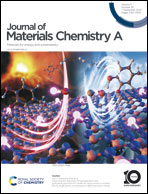Surface modulus reconstruction toward robust flexible perovskite solar cells†
Abstract
Flexible perovskite solar cells have attracted great attention due to their remarkable power-per-weight. Nevertheless, the high-modulus surface of the perovskite layer induces crack generation when subjected to mechanical deformation such as bending, twisting, and stretching, resulting in permanent loss of device performance. Herein, a thermoplastic polyether ester elastomer (TPEE) is employed to reconstruct the surface modulus of the perovskite layer to dissipate the stress and avoid stress concentration, preventing crack generation during deformation. Meanwhile, TPEE with high viscoelasticity effectively increases the interfacial adhesion effect between the perovskite layer and the electron transport layer, imparting the films with excellent bending resistance. The synergies endow the flexible device with excellent mechanical durability. The efficiency of the TPEE-based flexible perovskite solar cells reaches 19.38% and 90% and 80% of the initial efficiency is retained after 10 000 and 18 000 bending cycles at a 2 mm curvature radius, respectively. This strategy provides an effective method to solve the mechanical stability of the perovskite film and interfacial adhesion issues toward the robustness of flexible perovskite solar cells.



 Please wait while we load your content...
Please wait while we load your content...